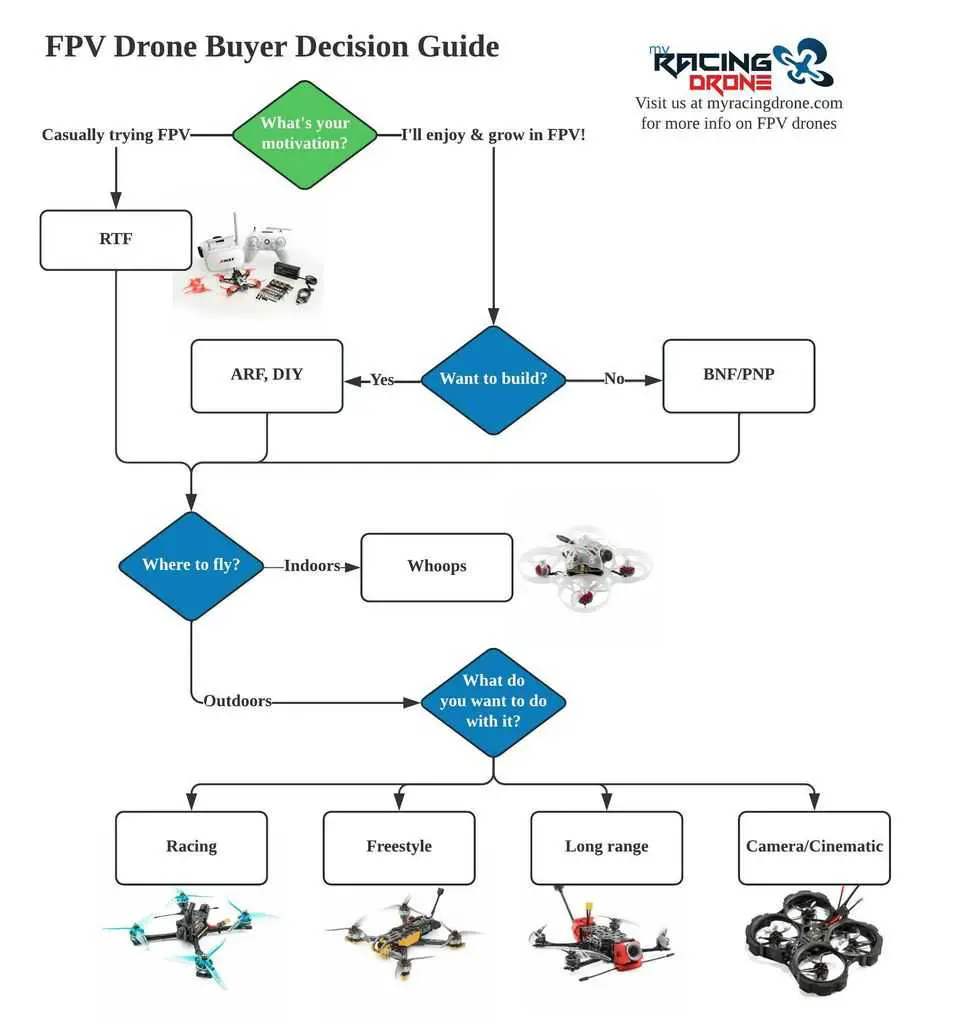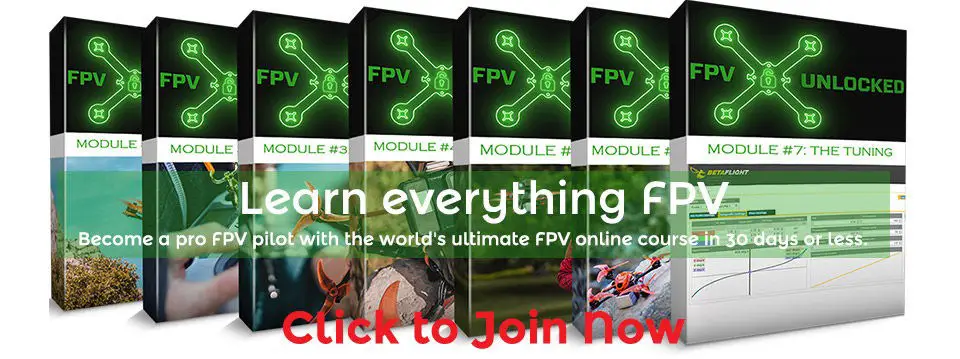Choosing the right FPV drone is the first step in this hobby, yet a difficult one. Depending on your need, there are multiple options that you have. In this article, I’ll guide you how to choose your first FPV drone based on your needs.
If you are just casually trying FPV, your first FPV drone can be an RTF drone. RTFs are cheap, beginner-friendly, and viable. If FPV is something that you’ll stick with, get a BNF and PNP, or DIY kit if you want to build. Whoops are for indoors. For outdoors, choose from racing, freestyle, long range, and cinematic drones.
Continue reading to understand more about your choices.
First Time FPV Buyer Decision Chart
Here’s a chart that helps you make a decision when buying your first FPV drone. I’ll elaborate further in the subsequent sections.

Differences between ARF, BNF, PNF/PNP, and RTF
When you are shopping for your drone, most likely you will see terms such as ARF, BNF, PNF/PNP, and RTF. What does that actually mean and which should you choose? Table below shows the definition of each term and things that are included in the package.
| Acronym | What’s in the package? | Suitable for |
|---|---|---|
| Almost Ready to Fly | Drone DIY kit. All parts are not assembled and you need to buy additional parts which are not included. | Those who prefer DIY or want to learn how to assemble a drone. |
| Bind and Fly | Drone only. No RC controller, goggles and battery. | Owner of more than 1 drone and beginners. |
| Plug and Fly/Play | Drone only. No RC controller, radio receiver, goggles and battery. | Pilots who have compatible and usable parts from a thrashed drone. |
| Ready to Fly | Include everything. | Beginners. |
Rationale for RTF as the First FPV Drone
If you are new to drones and wish to try it out, you should get an affordable RTF drone. It includes everything that you need to fly. You don’t need to worry about compatibility between components and setting up your controller. RTF is suitable for anyone with a budget limitation, and just want to fly casually.
I would strongly advise not to buy something too cheap. That will give you a bad experience on FPV, and probably stops you from staying in this hobby.
Why Should You Start with BNF/PNP?
If you think you will stick to the FPV hobby for a long time, it makes more sense to start with a more future-proof setup by getting BNF or PNP drones (check out my top picks).
This is because you will soon outgrow your RTF drone (and the included radio, goggles), making them a total waste. So, why not buy something that can last you longer in the first place?
Don’t go all out buying the most expensive FPV drone though (although it’s up to you). Since you will likely crash multiple times as a beginner, you might thrash your first drone. You can reduce the chance of that happening by practicing on simulators (see my best picks) and improving the durability of your drone.
The future-proofing that you should focus on is on the FPV goggles and radio transmitter. Since they can last you for a long time (and you will have to upgrade them anyway), you want to start with a good one. Here’s my top pick of radio transmitter and FPV goggles.
The only issue with BNF/PNP drones is that you need to pair and set up the radio by yourself (eg. which button does what). It is not difficult, and you’ll have to learn it anyway.
As you learn more, you may buy an ARF or DIY drone to learn how to build a drone, and ultimately build your own drones.

Indoor vs Outdoor Drones
If you plan to fly indoors, or at most, in your yard, a tiny whoop or mini drone is the best option. The props of the tiny whoops are protected, making it safe to fly indoors. You can fly tiny whoops outdoors, but beware that it can be easily swept away by wind.
If you are flying outdoors, you need a 3”, or minimum 2.5” drone. 5” drone is the most popular mini quad due to a good balance in speed, size and cost.
4S vs 6S Drones
If you choose to start with a 5” drone, you will hit a dilemma where you have to choose between 4S or 6S.
Most pilots agree that 6S drones are better than 4S because they are faster and more efficient. Going for 6S is a no brainer for pro pilots. But, as a beginner, that’s not the only thing that you should worry about.
6S LiPo packs are more expensive than the 4S packs. Taking the budget CNHL battery for example, 6S costs $30 while 4S costs $23. That’s a 7 bucks difference for every battery you buy.
We know LiPo batteries are dangerous if not handled properly. 6S LiPo are more dangerous than 4S in terms of the seriousness of explosion or fire if mishandled. Essentially, you have to choose between a smaller bomb and a bigger bomb (its an exaggeration but I hope you get what I mean). Of course, you can minimize the risk by proper LiPo care, storage and handling.
6S drones are more “punchy”, making them harder to control for beginners. I am sure that you will get used to it. Just be careful before you get yourself familiar with 6S’s control.
Which Type of FPV Drone Should You Buy?
There are so many types of FPV drones in the market: racing, freestyle, long range, and cinematic drones. Make sure you know what you want before you buy it.
Racing Drone
Racing drones are designed for racing. They are meant to be fast, powerful and lightweight. Most racing drones come in X design for the best aerodynamics.
Racing drones don’t have unnecessary features such as GPS. It is designed to drain all your battery juice in just a few minutes so that you can win races.
While factory-produced racing drones can’t beat a customized drone, they are pretty good! Especially if you buy a drone built following the specs used by World Champion.
Freestyle Drone
Freestyle drones are designed to dance in the air. They are agile and powerful, but not necessarily lightweight since most freestyle pilots will mount a GoPro on the drone.
Freestyle drones allow add-on features such as autonomous flight and GPS, depending on the pilot’s preference.
Similar to racing drones, freestyle drones consume your battery juice in just a few minutes, depending on your flight style.
Long Range Drone
Long range drones are designed for long range flight for up to a few miles. They shine in terms of superior flight range (signal strength and stability) and long flight time. However, they are usually slow and less powerful.
All long range drones should come with GPS and a beeper to help you find the crashed drone.
Cinematic Drone
Compared with camera drones, FPV drones can’t take good photos or video in the air due to the lack of stabilizer in the FPV camera. Normal FPV drones also can’t hover in the air, or get near to people without the risk of cutting them with its fast-spinning, naked props.
Cinematic drones are designed to carry a GoPro so that you can take good videos. It flies slower and it is less powerful. You can’t make certain tricks that a freestyle drone is capable of. But cinematic drones have ducts or prop guards to avoid hurting people when taking close shots.
A good cinematic drone comes with GPS, accelerometer, compass, and barometer sensors. That allows your drone to hold position and altitude while you are recording.
Budget

More expensive drones are generally better than their cheaper counterparts. However, a drone or a component that is twice the price doesn’t mean it is twice as good. It could be only 20% better. You will need to ask yourself whether you are willing to spend 100% more to achieve 20% more.
Ultimately, budget is the final decision-making factor. You should always spend within your means. You can buy an RTF drone for as little as $250, which is good enough for entry level FPV. But as you progress and out-grow your drone, you will have to spend more to upgrade your drone.
Bear in mind that there are other things that require you to spend money on, besides the drone itself. You might want to understand what else and how much you need to spend on the FPV hobby before deciding on the drone that you are going to buy.
Final Words
There are many other things that you could consider when choosing your first FPV drone. I can only provide you with pointers for your consideration from a beginner’s perspective. Ultimately, you need to consider what you really need the most. If you are keen to learn more about FPV, do explore my blog. I hope you will find something useful for you!
Don’t forget to also check out the 7 things that you need to know before buying an FPV drone and 10 common mistakes that you should avoid, if you haven’t.


